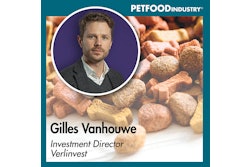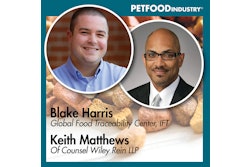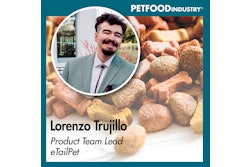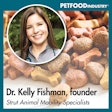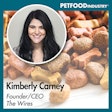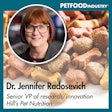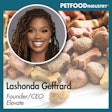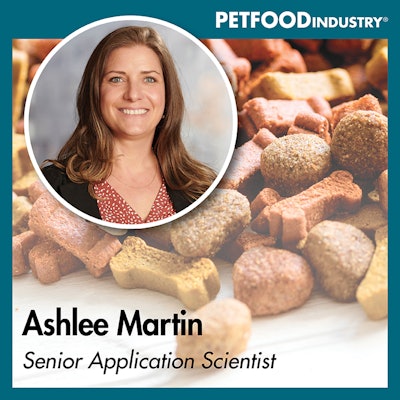
Host Lindsay Beaton speaks with Ashlee Martin, senior application scientist with Oterra, about natural colors in pet food and how the natural segment of pet food continues to evolve.
The below transcript is from Episode 54 of the Trending: Pet Food podcast where editor Lindsay Beaton spoke with Ashlee Martin, senior application scientist with Oterra, about natural colors in pet food and how the natural segment of pet food continues to evolve. You can find the episode at Trending: Petfood Podcast, on SoundCloud or on your favorite podcast platform. This episode originally aired on January 31.
We want to thank AFB International for sponsoring this podcast. AFB is the premier supplier of palatants to pet food companies worldwide, offering off-the-shelf and custom solutions and services that make pet food, treats and supplements taste great.
Lindsay Beaton – Editor, Petfood Industry magazine and Host, Trending: Pet Food podcast: Hello, and welcome to Trending: Pet Food, the industry podcast where we cover all the latest hot topics and trends in pet food. I’m your host and editor of Petfood Industry magazine, Lindsay Beaton, and I’m here today with Ashlee Martin, senior application scientist at Oterra. Hi, Ashlee, and welcome.
Ashlee Martin, senior application scientist at Oterra: Hi, thanks for having me.
Beaton: In case you're not familiar with Ashlee Martin, here's what you need to know.
Ashlee is a highly experienced professional with 19 years of expertise working with natural colors for food, including pet food. As a senior application scientist at Oterra, she is responsible for creating natural color solutions for the pet food industry and providing technical assistance to clients worldwide.
With her vast knowledge of Oterra’s natural color range, Ashlee helps customers achieve their desired shades that align with their brand. Oterra is the largest global provider of naturally sourced colors for the food, beverage, dietary supplements and pet food industries. Since the company's first color launch in 1876, they've drawn on the power of nature's true colors and champion that natural is best. They've done everything in their power to bring the very best of nature to consumers ever since.
Ashlee's extensive experience in the science and application of natural flavorings is why I've brought her on today to answer this question, what place do natural flavorings have in pet food formulations? We're going to talk about where they are right now. But first, I want to talk about how it came to be such a significant part of pet food formulations. We've been hearing more and more and more about natural colorings in the pet food formulations in the last several years. What brought on the rise of natural colorings in pet food to begin with?
Martin: I think the biggest thing that brought the rise of natural colors in pet food is the link to consumer preferences. Consumers prefer to feed their pets a more natural, healthier diet. They also desire transparency on the label. Pet parents are reading labels now like they never have before. They'll look at labels and compare one versus the other just as they would themselves or their children, so that's something new that consumers never did before. They just picked up their bag of dog food and went on their way. Now they're actually looking at it.
In response to this demand, I think pet food manufacturers have started developing more with natural colors. These sources are from plants or fruits and vegetables instead of the synthetic additives.
Beaton: Does it feel a little bit like a full circle moment, because the very first flavorings and colorings obviously were natural. Humans have been using natural colorings for everything from makeup to clothing to food for a long, long time, then the rise of synthetic colorings became a thing. Now we're kind of going back to natural coloring. Were they always there? Or did we completely replace them with synthetic and now we're reintroducing this option of natural again?
Martin: I think that we did actually. Before, I think it was 1938, the Food and Drug and Cosmetic Act was developed. That's when synthetic colors came to be. Before that, we just probably took whatever colors were natural, from natural sources -- didn't really care so much about it -- it was more on the cooking.
Then there was this big switch to make human foods safe in the 1920s and 1930s. They added all sorts of strange things to food that should not be in there. Then the Food Drug and Cosmetic Act came to be, basically saying, “You have these synthetic sources that are made safely. This is what you add in your food.” From that point on, synthetic colors were the most readily available and what consumers thought was safe. It really hasn't changed much since 1938. There have been some changes, but not much.
That’s the regulatory side of it, and now natural colors are making more of a presence because I think we're questioning what's in our food. We're questioning that just because the FDA says it's safe, what does that really mean because these laws are so old.
Beaton: Do natural colorings have to be added to the existing regulatory structure or is there a completely different regulatory structure for natural and they fall more under the natural category in that particular silo?
Martin: Yes, correct. There is a synthetic section. I don't know how technical you want me to get, but they're certified colors. When you see something that uses the F, D and C, that means that it's been certified for the government. That’s the color that you will purchase. Then there are colors that are exempt from certification. Those are the natural sources. That's where you'll find your fruit juice regulations, your vegetable juice regulation. They adhere to a strict standard, but they're in a different regulatory portion. They have always been there, it's just now there's more interest, there's more consumer desire for it.
Beaton: What is the current state of their use in pet food? Is it a lot on the food side, the treat side, all sides? What is the main thing that formulators are looking for when they come to you and ask for natural colorings?
Martin: There's really kind of two sides to the story. There's those who have been using synthetic colors and want to switch -- take out those synthetic colors, add natural colors. Then there is new product development, where they'll want to add a color to make it appear "meatier," more “vegetable.” You'll hear the dogs really don't care, because they can't really see it. They can see different intensities, and maybe shades of yellows and gray, but they're not going to pick it either -- it really is the consumer that is making those choices.
I think that now there's maybe a 50/50 split in the market. There are maybe more natural colors used in treats because that's kind of fun. You can play with holidays and things like that. Then the kibble, the dry food has historically been colored with synthetic colors. That's where we see a lot of that conversion from synthetic to naturals. And sometimes manufacturers just decide to take the color out completely. We have seen that. Then there's more of a question, when the consumers might think, “Oh, there's something wrong with my product, because it doesn't have these colors that I'm used to.”
Beaton: How does a pet food manufacturer know what type of color the consumers looking for? Because as you mentioned, dogs are not seeing it, they're not seeing the same things that we're seeing. So this is very arguably not for the pet. It is definitely for the human who's purchasing the product? What kind of conversations do you guys have in terms of “is this red enough”? Does it look authentic enough? Do you just go on what you think looks good to you? Or is there some research that says, “This kind of green is the right green? Or this kind of red is the right red?"
Martin: I would say no, there's probably not research. At least I'm not aware of it if there is. A lot of it is done through preference. When I make recommendations, I think of what I would like to see on the shelf. I am a pet owner. I am a consumer of pet foods and treats, so I use my own expertise and my own thought into what I would make that color look like.
For the manufacturer, it's often a marketing decision. Maybe they're trying to match an image or something else. But it's often a marketing decision. The larger manufacturers will invest the time and money into consumer testing. There are multiple different ways you can do consumer testing, either through images or actual product. They will take a sampling of the market to see what those consumers find more appealing.
Beaton: What are the most popular colors? Is it a lot of “make this meat look more like meat”? Is there a particular vegetable? If it's hard in processing, the color just gets stripped away and something needs to be added, are there some that you end up using over and over and over again for people?
Martin: One of the most popular colors today is black carrot. There's a product in the market that is a colored carrot, it's either called black carrot, purple carrot, violet carrot. It would be similar to something you might buy in the grocery store, where a purple carrot, but the pigment is all the way through so it's completely saturated, very high-color stirring. It's a very stable pigment. It provides a purple shade at a neutral pH and a red shade and a low pH. It's very readily available. That's my favorite color.
If we're going to talk about sources, that can be used to make things darker to make it look “meatier.” Nobody wants their kibble to be purple, but you do want it to look richer, darker. Orange also is a very nice pigment. Orange from a natto. We can use that pigment to brighten the shades. Again, maybe not make an orange kibble but make something look more like a salmon or richer and brighter.
Beaton: Since you touched on it. Let's dive into sourcing. How does sourcing work for natural colorings? In the last several years with the supply chain being the way that it has been, and with all the troubles that we had, especially a couple years ago at the height of the pandemic, what kind of challenges were there in trying to make sure you were still able to provide all these natural colorings when I'm guessing you had limited sources for at least some of the colors you provide?
Martin: Being a global color manufacturer, we really try to limit any sourcing concerns. These colors are grown all over the world. They grow in the regions where that crop flourishes. For example, black carrot, like I talked about before, is primarily grown in Turkey. Turmeric is primarily grown in India, while a natto is grown in South America and Africa.
We have manufacturing sites and collaborations with the farmers to ensure that our supply is always there. It's also important that these are naturally grown products. We have to deal a lot with forecasting. We need to know how much color we're going to need to sell. Some of these crops are only harvested once or twice a year. Some crops like sweet potatoes -- we have a Hansen sweet potato, a red-shade sweet potato -- which we grow and cultivate all year long. As soon as the crop comes out, we put in new seeds and grow another one.
Things like curcumin or cochineal, they take time to grow. Therefore, we need to have a crystal ball into the future -- who's all going to want natural colors? We do our best to make sure that we don't have those sourcing constraints. During COVID, I think everyone did. In that instance, when you can't ship your materials across the sea, because you can't get a container, then those are concerns. We all learned that in the sourcing world. It is something but it's top of mind.
Beaton: What are -- and this is a bit of a one-on-one question, but I'm sure it's something you get from new clients all the time -- what are some of the benefits and the challenges of using natural colorings compared to synthetic? Is it mostly price concern? Is it mostly a quality of color? An end user? What are the things that people come to you and ask about natural versus synthetic?
Martin: I think the most often top-of-mind is what the consumer wants. The negative perception -- new synthetic colors -- and just simply removing them from the product. In doing that there are concerns of price. I mean, your dosage is incredibly low in synthetic colors, so your dosage will be higher.
However, with extraction and technologies, we're really closing that gap between the price of synthetic colors and colors from natural sources. I think there's also this negative connotation to natural colors that they won't be as good as synthetic. Some companies, they're thinking, I'm not going to change my formula, it's not going to be as good, it's going to be difficult, time consuming, sourcing, you know, all those things that may be hurdles for natural colors. But really, again, with the technology, natural colors are not the same now as they even were 10 years ago. We've really made headway and making it easy.
When you work with a color supplier like Oterra, we can do some trials, we'll figure out and make it easiest for you. We've done stability testing, we know how these colors behave. We can make the right decisions and the right recommendations that get people to where they need to be with the color matching.
Beaton: How different is the process, really? I think I figured it wasn't one-to-one, but by the time you get the product to the person who needs it, I think I figured that maybe the concentration was different, but it was largely going to react the same way. I'm assuming now that that is not the case -- that synthetic colorings and natural colorings react differently in formulations.
Martin: That is correct. They do react differently. You can think of the synthetic color as straight chemicals. It's very little reactivity, just put in those pigments -- kind of like paint. There are some constraints. Like Red 3, for example, is light sensitive. Red 40 could degrade, so things like that. In general, you do have to pay attention to your product and make sure you're going to get the right concentration, the right performance from that natural color. There are certain things that you can do in manufacturing, like adding the color as late in process as possible, not blending the colors directly with acids or flavors. We call them tips and tricks.
If we’re starting with a client who has no idea about natural colors, we'll start with the tips and tricks just to get them on the right foot. That's how we make it easier to use natural colors.
Beaton: If there's somebody who's using synthetic colorings, and they want to switch to natural colorings, what does the start of that process look like? Do you talk about color matching? Do you talk about potential hurdles in the production of the pet food that this is going to end up in? Where's the starting point for switching over something like that?
Martin: Kind of all those things. Pet food manufacturing efficiency is important, so we may start out by talking about some issues that they're currently having with synthetics. Synthetic powders specifically can be very dusty; they can be very dirty. If there's some problems already happening, we might be able to solve those by using natural colors. We can provide colors that are less dusty, that are less hydroscopic, so they pick up less moisture in production.
If they're currently using liquids, do they need a liquid natural color or could they use the powder? Those are all kind of things that we talked about. One thing that comes up often with pet food is the ability of refrigerated storage. Sometimes they just don't have the storage to make natural colors work. Not all colors need to be refrigerated, but some do. Then we would avoid refrigerated storage if, for example, they don't have ample refrigerated containers. That's just one example of something that we try to think of -- all those questions ahead of time to avoid any surprises at the end.
Beaton: As the types of pet food available evolve and everything gets more complex in terms of what consumers want, kibble versus other forms of pet food, are you seeing the requests from people evolved to match that? Or are there some types of pet food that just do not need or use colorings at all? I'm assuming that you're largely still speaking with kibble or dry food customers but are you getting some other interesting requests as freeze-dried, air-dried, wet food -- all of that -- becomes more of a thing? And treats -- because treats are getting a lot more complex too.
Martin: Definitely with treats. Because I think with a treat, especially in like the meaty treats, they're very blah looking. We see a lot of requests to amp up the shade of those meatier treats.
You also mentioned the kibble. There is a large chunk of pet food that has no color whatsoever. There are large manufacturers that just they don't want it – that’s brown, they're fine. And that's great. Then in the other aspect of the kibble that was primarily colored with synthetic colors, I think taking those out is the request. There still is a huge chunk that is uncolored.
Beaton: When this episode comes out, it will be the beginning of 2024. I would be remiss if I didn't ask what you think the path of natural colorings is going to take this year. What are we looking at? Is there anything really interesting or exciting that you're looking forward to -- research-wise, colors-wise?
Martin: When we were talking about sourcing before, and different things that might happen in the future -- at Oterra, we’ve just launched a new source from a small fruit in Colombia. It's called the Jaguar fruit. It's a small fruit that produces a blue shade. That was something 15 years in the making with our partner to get us here, so that was very exciting and we're excited to use that in 2024. Unfortunately, at this point, it's not approved for pet food. It's approved for human food, and pet food is next. That's another regulatory hurdle to cross. In 2024, I'm excited to see the Jaguar blue come to market and next step would be using it in pet food.
That is the new face of natural colors. We've been using these same old sources for a very long time. There's a lot more interest now in new companies and new research, looking into fermentation, looking into new sources. The regulatory process for those things can be quite long, so maybe it's not going to happen in 2024. But there's the momentum and there's this desire for natural colors, both in human food and pet food, that's just going to continue growing.
I see more sources being discovered. I see better processes, more formulations -- seeing color in a different way than we've seen in the past.
Beaton: I always love talking to companies who work in the human space as well as the pet space because then I get to ask how applicable is the research in the human space to what you do in the pet food space? How similar are the requests? Are people looking for pretty much the same thing on the human side and the pet side, or are there very different reasons for wanting natural colorings on both sides?
Martin: I think it mimics each other, they both mimic what is happening. It seems to be moving almost faster on the pet side than it does on the human side. I think maybe certain brands on the human side are resistant to change. There are some iconic brands that just may never convert to natural colors. Whereas, I think on the pet side, it's all moving. The requests that we get from the customers are very similar with a very similar end goal.
As far as the processes -- the processes are all very similar also. We have extruded cereal, and we have extruded kibble. We use a lot of those learnings to talk with each other between pet and human. One thing that I always find super interesting is the regulatory restrictions. There are more restrictions for pet. There are more ingredient restrictions -- there's what can be approved, what can't be approved. It's much stricter on the pet side than it is on the human side, which I always find interesting.
Beaton: You talked about a new color that you guys have been working on, and you said that it's been in the works for a long time. How does that process happen? Do farmers or people come to you guys and say, “Hey, I have a thing that would make a great color?” Or do you guys get a request for a color, and you're like, “We don't have anything that matches exactly, so let's go try to hunt something down.” Who initiates that process of looking for a new color? Because at this stage of the game, it feels like you probably have every color under the sun.
Martin: It’s both. Internally, we have a team of research and development constantly looking for those new sources, looking for new ways to extract, constantly seeing what's out there. Then we also have our partners. In this instance, it was a partner. We probably would have never found a very small fruit in the jungles of Colombia. In that instance, it was a partner. It happens either way. We’re always looking.
Beaton: I want to wrap up our conversation with something actionable. So, say you are a smaller pet food manufacturer. You don't have endless resources, you've been using synthetic colors for whatever reasons, and you're thinking of switching to natural, maybe the consumers are asking for it. Maybe you feel like it better fits your brand. What is the very first step a company needs to take to see if that process is feasible, and one that they should take right now?
Martin: I'd say reach out to me on LinkedIn. Reach out to Oterra on LinkedIn. Go to our website, oterra.com. We have lots of good information there. They can lead you to an email and ask a question and we can get back to you. There are many ways to get a hold of us, either on LinkedIn or through the website.
Beaton: Awesome. Well, I really appreciate you taking the time to talk to me today because the natural segment of pet food continues to evolve and grow as customers get more particular about what ends up in their pet’s food. And like you said, they're reading labels like never before, even more than they're reading labels on their own food, honestly. It's interesting to hear about what that might continue to look like, especially from a coloring side of things. You're not necessarily going to think about that right off the bat unless you work in colorings, and that is your bread and butter. There are a lot of ingredients and natural sourcing and things like that, but colors come from somewhere too. I really appreciate you taking the time to speak with me today.
Martin: Thank you.
Beaton: That's it for this episode of Trending: Pet Food. You can find us on PetfoodIndustry.com, SoundCloud or your favorite podcast platform. You can also follow us on Instagram @trendingpetfoodpodcast. And if you want to chat or have any feedback, I'd love to hear from you. Feel free to drop me an email: [email protected]. And, of course, thanks again to our sponsor, AFB International, the premier supplier of palatants to pet food companies worldwide, offering off-the-shelf and custom solutions and services that make pet food, treats, and supplements taste great. Once again, I'm Lindsay Beaton, your host and editor of Petfood Industry magazine, and we'll talk to you next time. Thanks for tuning in!


